

Hundred Years' War. The Hundred Years' War, a series of conflicts waged from 1337 to 1453, pitted the Kingdom of England against the Valois Capetians for control of the French throne.

Each side drew many allies into the fighting. Edward responded by declaring himself to be the rightful King of France rather than Philip, a claim dating to 1328 when Edward's uncle, Charles IV of France, died without a direct male heir. Endemic warfare. Endemic warfare is the state of continual, low-threshold warfare in a tribal warrior society.
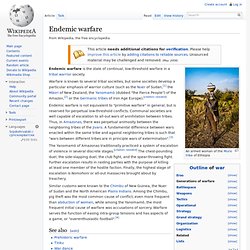
Warfare is known to several tribal societies, but some societies develop a particular emphasis of warrior culture (such as the Nuer of Sudan,[1] the Māori of New Zealand, the Yanomamö (dubbed "the Fierce People") of the Amazon,[2] or the Germanic tribes of Iron Age Europe). [citation needed] Endemic warfare is not equivalent to "primitive warfare" in general, but is reserved for perpetual low-threshold conflicts. Peasants' Revolt. The Peasants' Revolt, also called Wat Tyler's Rebellion or the Great Rising, was a major uprising across large parts of England in 1381.

The revolt had various causes, including the socio-economic and political tensions generated by the Black Death in the 1340s, the high taxes resulting from the conflict with France during the Hundred Years War, and instability within the local leadership of London. The final trigger for the revolt was the intervention of a royal official, John Bampton, in Essex on 30 May 1381. His attempts to collect unpaid poll taxes in the town of Brentwood ended in a violent confrontation, which rapidly spread across the south-east of the country. A wide spectrum of rural society, including many local artisans and village officials, rose up in protest, burning court records and opening the local gaols. Jacquerie. This article is about a specific 14th century French peasant uprising.
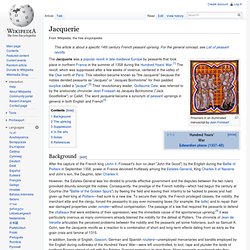
For the general concept, see List of peasant revolts. Background[edit] Crisis of the Late Middle Ages. The Crisis of the Late Middle Ages refers to a series of events in the fourteenth and fifteenth centuries that brought centuries of European prosperity and growth to a halt.[1] Three major crises led to radical changes in all areas of society - they were demographic collapse, political instabilities and religious upheavals.

A series of famines and plagues, beginning with the Great Famine of 1315-1317 and especially the Black Death of 1348, reduced the population perhaps by half or more as the Medieval Warm Period came to a close and the first century of the Little Ice Age began. Along with depopulation came social unrest and endemic warfare. Italian Renaissance. Renaissance of the 12th century. The Renaissance of the 12th century was a period of the many changes at the outset of the High Middle Ages.
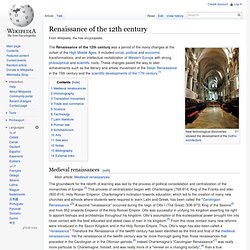
It included social, political and economic transformations, and an intellectual revitalization of Western Europe with strong philosophical and scientific roots. These changes paved the way to later achievements such as the literary and artistic movement of the Italian Renaissance in the 15th century and the scientific developments of the 17th century.[1] Medieval renaissances[edit] The groundwork for the rebirth of learning was laid by the process of political consolidation and centralization of the monarchies of Europe.[2] This process of centralization began with Charlemagne (768-814) King of the Franks and later (800-814), Holy Roman Emperor. Charlemagne's inclination towards education, which led to the creation of many new churches and schools where students were required to learn Latin and Greek, has been called the "Carolingian Renaissance.
Condemnations of 1210–1277. The Condemnations at the medieval University of Paris were enacted to restrict certain teachings as being heretical.
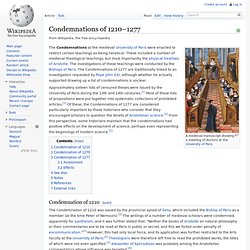
These included a number of medieval theological teachings, but most importantly the physical treatises of Aristotle. The investigations of these teachings were conducted by the Bishops of Paris. The Condemnations of 1277 are traditionally linked to an investigation requested by Pope John XXI, although whether he actually supported drawing up a list of condemnations is unclear. Protestant Reformation. Western Schism. Map showing support for Avignon (red) and Rome (blue) during the Western Schism; this breakdown is accurate until the Council of Pisa (1409), which created a third line of claimants..
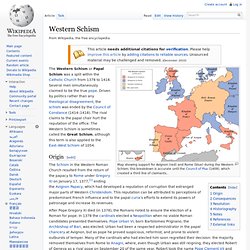
Origin[edit] The conflicts quickly escalated from a church problem to a diplomatic crisis that divided Europe. Secular leaders had to choose which claimant they would recognize: In the Iberian Peninsula there were the Ferdinand Wars (Guerras fernandinas) and the 1383–1385 Crisis in Portugal, during which dynastic opponents supported rival claimants to the papal office. Consequences[edit] Sustained by such national and factional rivalries throughout Catholic Christianity, the schism continued after the deaths of both initial claimants; Boniface IX, crowned at Rome in 1389, and Benedict XIII, who reigned in Avignon from 1394, maintained their rival courts. Efforts were made to end the Schism through force or diplomacy. Resolution[edit] Historiography[edit] According to Broderick: Notes[edit]
Science in the Middle Ages. The history of science is the study of the historical development of science and scientific knowledge, including both the natural sciences and social sciences.

(The history of the arts and humanities is termed as the history of scholarship.) From the 18th century through late 20th century, the history of science, especially of the physical and biological sciences, was often presented in a progressive narrative in which true theories replaced false beliefs.[1] More recent historical interpretations, such as those of Thomas Kuhn, tend to portray the history of science in more nuanced terms, such as that of competing paradigms or conceptual systems in a wider matrix that includes intellectual, cultural, economic and political themes outside of science.[2] Science is a body of empirical, theoretical, and practical knowledge about the natural world, produced by scientists who emphasize the observation, explanation, and prediction of real world phenomena. Medieval technology. Medieval port crane for mounting masts and lifting heavy cargo in the former Hanse town of Danzig[1] Medieval technology refers to the technology used in medieval Europe under Christian rule.
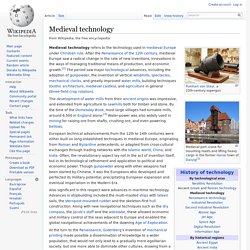
After the Renaissance of the 12th century, medieval Europe saw a radical change in the rate of new inventions, innovations in the ways of managing traditional means of production, and economic growth.[2] The period saw major technological advances, including the adoption of gunpowder, the invention of vertical windmills, spectacles, mechanical clocks, and greatly improved water mills, building techniques (Gothic architecture, medieval castles), and agriculture in general (three-field crop rotation).
The development of water mills from their ancient origins was impressive, and extended from agriculture to sawmills both for timber and stone. Civil technologies[edit] Medieval philosophy. Printing. Printing is a process for reproducing text and images, typically with ink on paper using a printing press. It is often carried out as a large-scale industrial process, and is an essential part of publishing and transaction printing. The earliest form of printing was woodblock printing, with existing examples from China dating to before 220 A.D.[1] Later developments in printing include the movable type, first developed by Bi Sheng in China,[2] and the printing press, a more efficient printing process for western languages with their more limited alphabets, developed by Johannes Gutenberg in the fifteenth century.[3] History[edit] Woodblock printing[edit] Woodblock printing is a technique for printing text, images or patterns that was used widely throughout East Asia.
Medieval Warm Period. Northern hemisphere temperature reconstructions for the past 2,000 years. The Medieval Warm Period (MWP), Medieval Climate Optimum, or Medieval Climatic Anomaly was a time of warm climate in the North Atlantic region that may also have been related to other climate events around the world during that time, including in China[1] and other countries,[2][3][3][4][5][6][7] lasting from about AD 950 to 1250.[8] It was followed by a cooler period in the North Atlantic termed the Little Ice Age.
Some refer to the event as the Medieval Climatic Anomaly as this term emphasizes that effects other than temperature were important.[9][10] Initial research[edit] Little Ice Age. The reconstructed depth of the Little Ice Age varies between different studies (anomalies shown are from the 1950–80 reference period) The Little Ice Age (LIA) was a period of cooling that occurred after the Medieval Warm Period (Medieval Climate Optimum).[1] While it was not a true ice age, the term was introduced into the scientific literature by François E. Matthes in 1939.[2] It has been conventionally defined as a period extending from the sixteenth to the nineteenth centuries,[3][4][5] or alternatively, from about 1350 to about 1850,[6] though climatologists and historians working with local records no longer expect to agree on either the start or end dates of this period, which varied according to local conditions.
Several causes have been proposed: cyclical lows in solar radiation, heightened volcanic activity, changes in the ocean circulation, an inherent variability in global climate, or decreases in the human population. Areas involved[edit] Great Famine of 1315–1317. From the Apocalypse in a Biblia Pauperum illuminated at Erfurt around the time of the Great Famine. Death ("Mors") sits astride a lion whose long tail ends in a ball of flame (Hell). Famine ("Fames") points to her hungry mouth. The Great Famine of 1315–1317 (occasionally dated 1315–1322) was the first of a series of large scale crises that struck Europe early in the fourteenth century. Places affected include continental Europe (extending east to Russia and south to Italy) as well as Great Britain.[1] It caused millions of deaths over an extended number of years and marks a clear end to an earlier period of growth and prosperity between the eleventh to thirteenth centuries.
The Great Famine started with bad weather in spring 1315, universal crop failures lasted through 1316 until summer harvest in 1317; Europe did not fully recover until 1322. Black Death. Hanseatic League. Late Middle Ages.